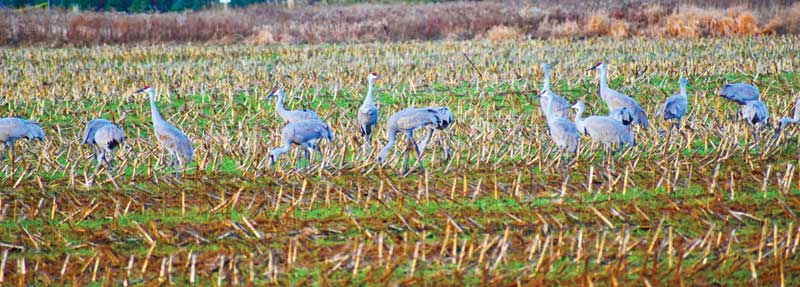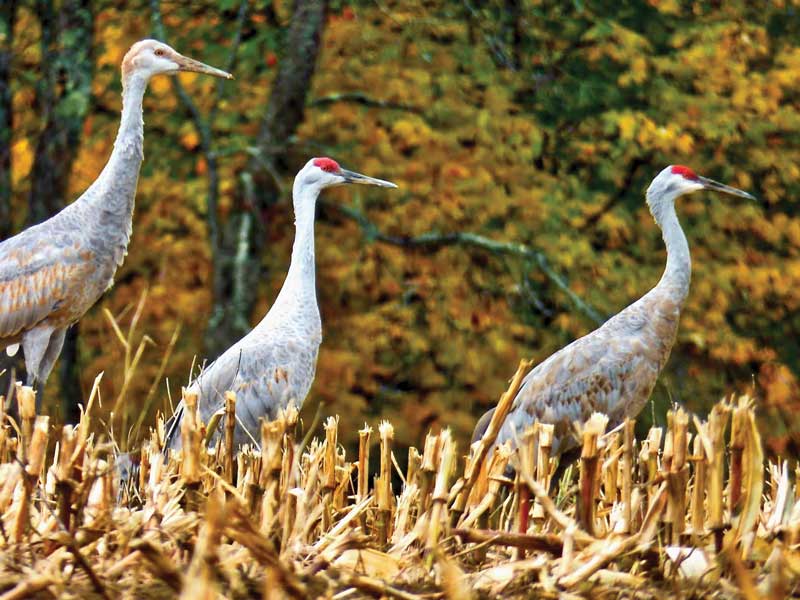
Once a rarity, sandhill cranes are visiting central Maine’s fields and marshes, especially in the fall when their annual migration gets underway.
Few natural sounds are more pleasing than the calls of these birds. Their elongated windpipes, coiled in the sternum, produce loud, rolling, trumpet-like vocalizations that last several seconds and can be heard two miles away, long before the flying cranes are visible.
In Maine, their calls are becoming more frequent as crane populations increase, especially in agricultural lands bordering freshwater marshes. The Pine Tree State’s few historical crane records are inconclusive. The late Ralph Palmer, a highly respected Maine naturalist and author of Maine Birds, published in 1949, wrote, “It seems possible that, in early times, Grus canadensis [sandhill cranes] may have nested in the northeast.” (Note: The birds have since been reclassified as Antigone canadensis.)
In his seminal book, Birds of Maine, published in 2020, my late friend Peter Vickery describes sandhill cranes as “uncommon migrants and rare breeders in open wetlands in central Maine.” Vickery based his conclusion, in part, on the state’s first documented pair of nesting sandhill cranes in 2000. According to Vickery, cranes have been infrequently reported, beginning in 1961 in Brunswick. Additional sightings were reported throughout the 1960s, but none documented nesting birds.
In 2000, my former Maine Department of Inland Fisheries and Wildlife colleague Scott Melvin located a pair of nesting cranes at Messalonskee Marsh in Belgrade, across from Hammond Lumber Company’s flagship store. Twenty-five years later, at least one, and possibly a second, pair of sandhill cranes continues to nest at the marsh. I’ve often seen adults foraging for snails, snakes, frogs, and rodents in hayfields bordering the Minot Hill Road between Hammond Lumber and Belgrade’s Old South Church.
Although relative newcomers, Maine’s cranes have quickly developed a large, loyal fan base—one that grows each year. One of the cranes’ endearing qualities is that they mate for life. They court their partners with elaborate dancing maneuvers. Displaying birds stretch their wings—which can span 6 to 7 feet—pump their heads, bow, vocalize, and leap into the air in a graceful and energetic mini-flight. It’s a thrilling ritual I’ve witnessed dozens of times without it ever growing old.

Adult females usually lay two eggs but only one nestling typically survives to fledge. Mated pairs and their juvenile offspring stay together throughout the winter. By the following spring, 9- to 10-month-old juveniles separate from their parents and become independent. During migration and winter, family units gather with other families and nonbreeders to form roosting and feeding flocks. There’s safety in numbers.
Throughout North America, cranes are revered for their power, grace, and beauty. This is particularly true among many Native American tribes, as I learned years ago from a Cree named James Pretty Paint. One June day outside of Havre, Montana, I had stopped along a road near the Cree reservation to observe the courtship display of a pair of cranes. Pretty Paint stopped his truck and joined me. He explained that for the Cree, cranes symbolize leadership, faithfulness, commitment, and new beginnings. As we watched the cranes dance, he shared a story of how cranes acquired their red crown and long legs. “Crane,” he said, “was the only bird willing to help Rabbit visit the moon. With Rabbit clutching Crane’s legs, the bird flew so close to the sun, the top of its head turned red from sunburn. During the long flights to and from the moon, Rabbit’s weight stretched Crane’s legs five times their normal length. And that’s why today, cranes have red crowns and very long legs.”
Cranes have also been revered for centuries in China, Korea, and Japan where the majestic birds contribute to each country’s rich cultural history.
Their elegant, long white feathers and long lifespan have made them a beloved symbol. The red-crowned crane, for example, is the national bird of China. The birds symbolize good fortune, happiness, longevity, good health, fertility, and peace. Cranes are frequently depicted in traditional Japanese art and origami, as well.
Our reverence for cranes is showcased each spring in Nebraska when thousands of visitors, including me, have witnessed the arrival of several hundred thousand migrating sandhill cranes in the Platte River Valley. Nebraska’s annual migration of cranes consistently ranks as one of the world’s greatest wildlife spectacles.
Unlike Nebraska’s spring congregation of cranes, though, Maine’s flocks of migrating cranes congregate each November in the harvested cornfields of Smithfield and Norridgewock. It’s a spectacle unrivaled in Maine or elsewhere east of Nebraska’s Platte River. On November 10, 2023, I counted 78 cranes in one Norridgewock field.
A day later, a few fellow birders also reported seeing the same number. For reasons known only to cranes, flocks mysteriously converge each fall in Smithfield and Norridgewock, arriving from across Maine and perhaps eastern Canada.
As many wildlife species decline globally, Maine’s growing sandhill crane population is a wonderful anomaly. Cranes are a welcome addition to the state’s rich, diverse wildlife tapestry. Grab a set of binoculars and drive to Smithfield and Norridgewock to see the cranes. Your best chance of encountering the unmistakable birds is by searching fields near Route 8 (Smithfield Road) between Smithfield and Norridgewock; Martin Stream Road, Route 2 (Mercer Road) west of Norridgewock; Oak Hill Road; and Wilder Hill Road. Enjoy viewing the cranes from the pavement and please do not approach the birds for two reasons. One, private landowners deserve our respect and gratitude for providing habitat for cranes and other wildlife. Refrain from trespassing. Two, the four-foot-tall cranes require rest and food to fuel their arduous flights to Florida, Texas, and Mexico. The sight and sound of these wonderful birds will warm your heart.
✮
Ron Joseph of Sidney, Maine, is author of Bald Eagles, Bear Cubs, and Hermit Bill: Memories of a Maine Wildlife Biologist, published by Islandport Press.
For More Information
Hear the trumpeting calls of sandhill cranes as they strut about:
Watch footage of Nebraska’s annual migration of cranes:






